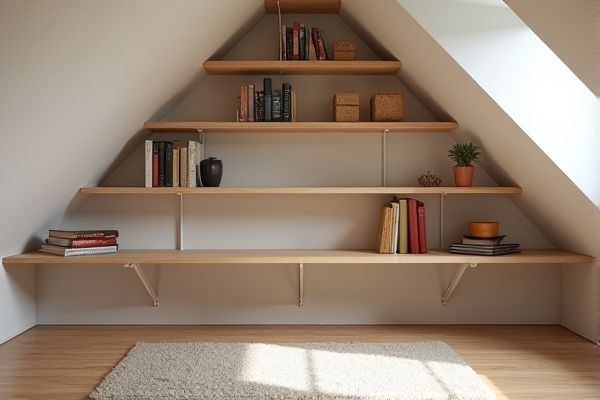
Attic step shelves offer a tiered storage solution ideal for maximizing space in irregular attic areas, while straight shelves provide a simple, linear approach suitable for straightforward storage needs. Discover which shelf design best fits your attic organization goals in the rest of this article.
Table of Comparison
| Feature | Attic Step Shelf | Straight Shelf |
|---|---|---|
| Design | Tiered steps for incremental storage | Flat, linear surface |
| Space Efficiency | Maximizes vertical space in attics | Utilizes horizontal wall or floor area |
| Installation | Requires angled or irregular attic walls | Easy mounting on standard walls |
| Use Case | Ideal for attic organization and storage | Suitable for general storage and display |
| Material Options | Wood, metal, or composite materials | Wood, metal, glass, or plastic |
| Weight Capacity | Moderate, depends on step size | Varies, generally higher load support |
| Aesthetic | Functional, space-conscious design | Sleek, minimalistic or decorative |
Introduction to Attic Step Shelf vs Straight Shelf
Attic step shelves offer a tiered design that maximizes vertical storage space, ideal for organizing items in tight or sloped attic areas. Straight shelves provide a simple, linear structure, making them suitable for uniform storage and easy access across flat wall surfaces. Your choice between an attic step shelf and a straight shelf depends on space constraints and the specific storage needs in your attic.
Understanding Attic Step Shelves
Attic step shelves are designed with staggered tiers that follow the slope of the roof, maximizing storage in angled attic spaces by providing easy access to items on each level. Straight shelves, in contrast, maintain a uniform horizontal line and may not utilize the sloped ceiling area effectively, limiting storage potential in attics. Understanding attic step shelves involves recognizing their ability to adapt to restricted headroom while offering organized, accessible storage tailored to the unique shape of attic rooms.
What Is a Straight Shelf?
A straight shelf is a horizontal storage unit designed for easy access and installation, commonly used in closets, pantries, and garages for organizing items efficiently. Unlike attic step shelves, which use tiered levels to maximize vertical space in attics, straight shelves provide a flat, linear surface ideal for storage and display. Their simple design allows for versatile placement along walls, making them a practical choice for maximizing horizontal space in various rooms.
Key Differences Between Attic Step and Straight Shelves
Attic step shelves feature staggered, stepped surfaces that maximize vertical space utilization, ideal for storing items of varied heights within tight attic spaces. Straight shelves provide uniform horizontal surfaces suited for consistent storage needs and easier accessibility of items in standard rooms. Your choice depends on space constraints and the type of items to be stored, with attic step shelves offering a more versatile solution in angled or limited overhead areas.
Space Optimization: Step Shelf vs Straight Shelf
Step shelves maximize attic space by utilizing vertical height variations, allowing for storage of both tall and short items efficiently in sloped ceilings. Straight shelves offer uniform storage but often leave underutilized space in angled attic areas, resulting in less optimized use of available volume. Choosing step shelves enhances spatial optimization by conforming to attic contours, increasing overall storage capacity compared to straight shelves.
Installation Methods for Each Shelf Type
Attic step shelves typically require installation through mounting brackets or hinges that allow the shelf to fold or flip up, providing easy access and space-saving functionality. Straight shelves are generally installed with fixed brackets or wall anchors that support a continuous, level surface ideal for straightforward storage solutions. Your choice depends on whether you prefer a dynamic, space-efficient option with the attic step shelf or a simpler, sturdy storage solution with the straight shelf.
Durability and Load-Bearing Capabilities
Attic step shelves typically feature reinforced joints and thicker materials, providing enhanced durability and superior load-bearing capabilities compared to standard straight shelves. Straight shelves are often simpler in construction and may support lighter loads, making them less ideal for heavy storage in attic spaces. You can maximize storage efficiency and safety by choosing an attic step shelf when durability and heavy load support are critical.
Aesthetic Considerations and Design Choices
Attic step shelves offer a unique, multi-level design that creates visual interest and allows for varied display heights, enhancing room aesthetics with a dynamic, architectural look. Straight shelves provide a clean, minimalist appearance, ideal for modern or streamlined interiors, emphasizing simplicity and uniformity in design. Choosing between attic step and straight shelves depends on the desired ambiance, room style, and personal preference for either layered visual depth or straightforward functionality.
Best Use Cases for Attic Step and Straight Shelves
Attic step shelves offer ideal storage solutions for angled or sloped ceilings, maximizing space in attics, lofts, and crawl spaces by conforming to unique rooflines. Straight shelves provide versatile and uniform storage suitable for garages, basements, or closets with straight walls and ample vertical clearance. Your choice depends on the structural layout and storage needs, ensuring efficient organization and optimal use of available space.
Which Shelf Type Is Right for Your Attic?
Attic step shelves offer a tiered design that maximizes vertical space and makes it easier to access items stored higher up, ideal for attics with varying ceiling heights. Straight shelves provide a uniform storage surface, best suited for attics with consistently high and straight walls, allowing for straightforward organization and stacking. Choosing between attic step shelves and straight shelves depends on your attic's ceiling shape and the type of items you need to store efficiently.
 homyna.com
homyna.com